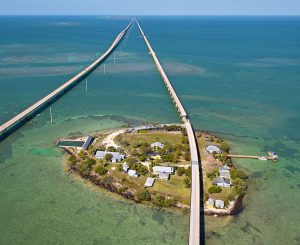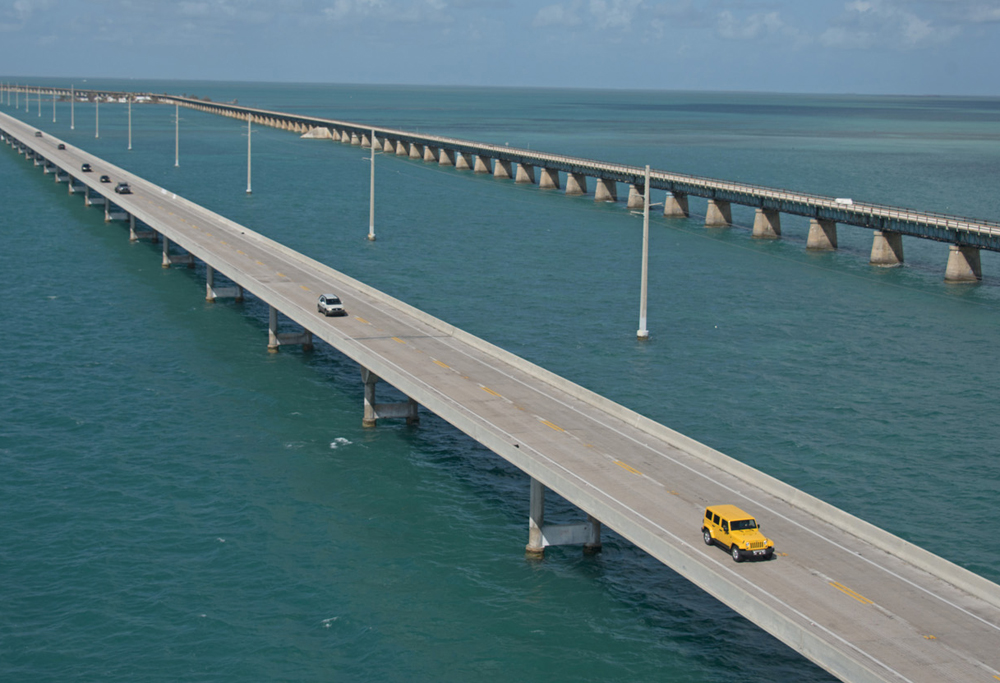Everyone traveling the length of the Florida Keys on the famed Overseas Highway crosses the Seven Mile Bridge — a fascinating engineering marvel that quite simply stuns the senses. Rising in an arc toward its center, the 35-year-old Middle Keys bridge offers sweeping panoramic views of a picturesque horizon where turquoise-colored seas meet an almost impossibly blue sky.

Pigeon Key, the one-time base camp for the workers that constructed Henry Flagler’s Florida Keys Over-Sea Railroad, lies beneath the original Seven Mile Bridge. (Photo by Andy Newman, Florida Keys News Bureau)
The original Seven Mile Bridge, now called the Old Seven Mile Bridge (or “Old Seven”), runs parallel to the modern structure. It was converted from a railroad bridge in 1938 to carry cars, and did so for 44 years.
The two salt-sprayed structures — recognized throughout the world as enduring symbols of the Keys — still withstand the test of time, even when lashed by storm winds and water.
The modern-day bridge, opened to traffic in 1982, is one of the world’s longest segmental bridges at 6.79 miles (or nearly 36,000 feet) long. A 65-foot-high clearance allows boat passage between the Gulf of Mexico and Atlantic Ocean.
Built from precast concrete sections with 440 spans, the iconic bridge connects Marathon to the Lower Keys.
Each year in April, up to 1,500 athletes test their endurance in the annual Seven Mile Bridge Run, an event that lures avid runners of all ages. This year’s race, the 37th, is scheduled Saturday, April 14.
Begun in 1982, the popular footrace over the convergence of the Atlantic and Gulf marked the completion of a massive construction project: building 37 new Keys bridges to replace the converted railroad bridges that dated back to the early 1900s.

About 1,500 competitors run across the convergence of the Atlantic Ocean and Gulf of Mexico during the annual Seven Mile Bridge Run near Marathon. (Photo by Andy Newman, Florida Keys News Bureau)
Just getting a chance to compete is nearly as challenging as the race itself. The 1,500-runner field almost always fills shortly after registration opens.
The Old Seven Mile Bridge, listed on the National Register of Historic Places, was built as part of railroad baron Henry Morrison Flagler’s Florida Keys Over-Sea Railroad. Completed in 1912, the rail line stretched from Florida’s southern mainland to Key West.
Construction of Old Seven was grueling. The bridge’s four sections consisted of steel-girder spans laid on top of concrete foundation piers.
The piers were secured to bedrock up to 28 feet deep below the waterline, and a swinging span allowed boat passage between the Gulf and Atlantic.
In recent years, a 2.2-mile section of Old Seven has been a popular spot for walking, running, biking and fishing — and as the gateway to 5-acre Pigeon Key, the historic railroad work camp where up to 400 workers lived from 1908 to 1912.
These days Old Seven is closed for restoration, with completion set for 2021. Visitors can reach Pigeon Key on a ferry that departs from the Hyatt Place’s marina at the Faro Blanco Lighthouse.

Affectionately nicknamed “Fred,” this sturdy but unexpected tree has grown and flourished in the roadbed of the Old Seven Mile Bridge.
On Pigeon Key, they can soak up the spot’s serenity and historic impact while touring the former section gang quarters, former paint foreman’s dorm and intriguing museum — and gaze up at the majestic new bridge that leads contemporary visitors to the Lower Keys.
For Florida Keys locals returning home, the sight of the two parallel Seven Mile bridges provides a warm, comforting welcome.
A glimpse of “Fred,” an Australian pine tree growing out of Old Seven’s roadbed, typically inspires a smile and a wave.
The two bridges stand resolutely — an enduring legacy to Flagler, the persevering dreamer who envisioned what the Keys would become.

